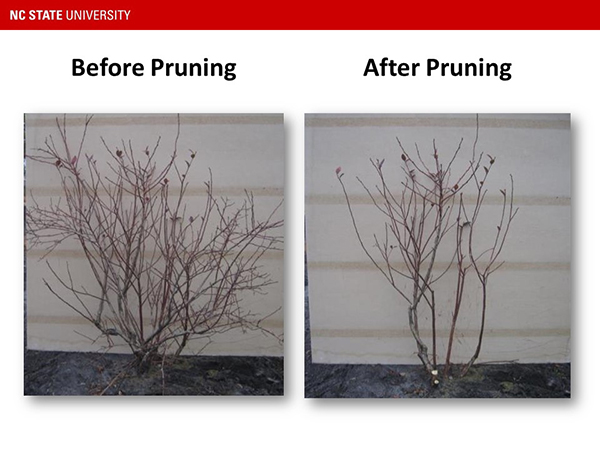February Is a Great Time to Prune Blueberries!
go.ncsu.edu/readext?909940
en Español / em Português
El inglés es el idioma de control de esta página. En la medida en que haya algún conflicto entre la traducción al inglés y la traducción, el inglés prevalece.
Al hacer clic en el enlace de traducción se activa un servicio de traducción gratuito para convertir la página al español. Al igual que con cualquier traducción por Internet, la conversión no es sensible al contexto y puede que no traduzca el texto en su significado original. NC State Extension no garantiza la exactitud del texto traducido. Por favor, tenga en cuenta que algunas aplicaciones y/o servicios pueden no funcionar como se espera cuando se traducen.
Português
Inglês é o idioma de controle desta página. Na medida que haja algum conflito entre o texto original em Inglês e a tradução, o Inglês prevalece.
Ao clicar no link de tradução, um serviço gratuito de tradução será ativado para converter a página para o Português. Como em qualquer tradução pela internet, a conversão não é sensivel ao contexto e pode não ocorrer a tradução para o significado orginal. O serviço de Extensão da Carolina do Norte (NC State Extension) não garante a exatidão do texto traduzido. Por favor, observe que algumas funções ou serviços podem não funcionar como esperado após a tradução.
English
English is the controlling language of this page. To the extent there is any conflict between the English text and the translation, English controls.
Clicking on the translation link activates a free translation service to convert the page to Spanish. As with any Internet translation, the conversion is not context-sensitive and may not translate the text to its original meaning. NC State Extension does not guarantee the accuracy of the translated text. Please note that some applications and/or services may not function as expected when translated.
Collapse ▲
Blueberries at the farmers’ market. Photo by Debbie Roos.
Blueberries are a popular crop for commercial farmers as well as home gardeners in North Carolina. They are fairly easy to grow if provided the right conditions and don’t require pesticides to produce a good crop. This makes them a popular choice among organic growers.
Blueberries require annual pruning to reliably produce a high quality crop and maintain bush height to facilitate harvest. Pruning can sometimes intimidate new growers who call Cooperative Extension for help and advice. I have teamed up several times with NC State University Blueberry Specialist Bill Cline to conduct blueberry pruning demonstrations in Chatham County.

NCSU Blueberry Specialist Bill Cline demonstrates how to prune rabbiteye blueberry plants at Howard’s Farm in Chatham County for a Cooperative Extension workshop. Photo by Debbie Roos.
Blueberry pruning is done during the dormant season, usually between December-early March in the piedmont. Many people are reluctant to prune because it removes some of the flower buds and reduces berry production for the year, but if pruning is neglected berries get increasingly smaller and bush health declines. Consider pruning an investment in the long-term success of your plants!

Pruning diagram. Graphic by Bill Cline.

Side-by-side comparison of blueberry bushes before and after pruning. Slide by Bill Cline.

Blueberry flower buds are formed in late summer and early fall. If fully pollinated, each flower bud can produce 3-7 berries. Photo by Debbie Roos.
NC State University has some excellent resources to help growers with blueberry pruning. Once you understand the why and how of pruning it all makes sense and you will be ready to prune your own bushes!
This video of Bill Cline narrating a Power Point presentation all about blueberry pruning is very helpful because he uses graphics and photos to explain how to prune blueberries. I highly recommend you start by watching this:
Blueberry Pruning Video with Bill Cline
Bill has put together other excellent guides full of helpful illustrations showing how to prune – these are linked below, along with some other resources I think are useful. Make sure to check them out!
Pruning Blueberries:
Blueberry Pruning Video with Bill Cline
Video of Bill Cline Conducting a Blueberry Puning Workshop and Demonstration
Blueberry Production and Pruning in North Carolina – North Carolina State University
Pruning Blueberries Fact Sheet – North Carolina State University
General Blueberry Production:
Recordings of Blueberry Production Webinars from Fall 2021 – Growing Small Farms
Blueberry Growers Portal – NC State Extension
The NC Blueberry Journal (blog) – North Carolina State University
Blueberry Freeze Damage and Protection Measures – North Carolina State University
2019 Blueberry School – Southern Region Small Fruit Consortium
Grower Resource List for Fruits – NC State Extension
Postharvest Produce Guide: Blueberries – NC Fresh Produce Safety
Weather and Climate: Blueberries – NC State Extension
The Southern Region Small Fruit Consortium
Organic Blueberry Production – ATTRA
Blueberry Pollinators – NC State Extension
Lowering the Soil pH with Sulfur – Michigan State University
Blueberry Pest Management Resources
Blueberry Disease Notes – NC State Extension
Blueberry Insect Pests – NC State Extension
2024 Southeast Regional Blueberry IPM Guide – Southern Region Small Fruit Consortium
Spotted Wing Drosophila Biology – NC State Extension

Blueberry blooms. Photo by Debbie Roos.
NC State University and N.C. A&T State University commit themselves to positive action to secure equal opportunity and prohibit discrimination and harassment regardless of age, color, disability, family and marital status, genetic information, national origin, political beliefs, race, religion, sexual identity (including pregnancy), and veteran status. NC State University, N.C. A&T State University, U.S. Department of Agriculture, and local governments cooperating. Persons with disabilities and persons with limited English proficiency may request accommodations to participate by contacting Ginger Cunningham, County Extension Director, at 919-542-8202, ginger_


